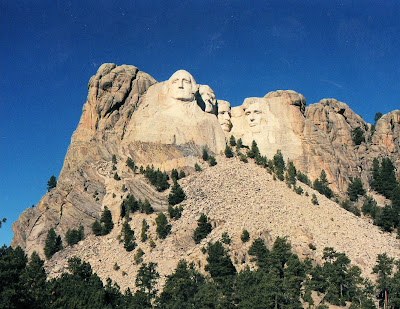 There are few monuments in the world like Mt. Rushmore. Not simply because it is a clearly American monument but because it is three-dimensional, as if the four presidents depicted here were standing on as much as being a part of the mountain itself. Some will argue that the Crazy Horse monument less than 20 miles away is larger, more appropriate to the setting and other such arguments but Mt. Rushmore at least was a first of its kind, drawing some two million inspired visitors to almost the middle of nowhere each year.
There are few monuments in the world like Mt. Rushmore. Not simply because it is a clearly American monument but because it is three-dimensional, as if the four presidents depicted here were standing on as much as being a part of the mountain itself. Some will argue that the Crazy Horse monument less than 20 miles away is larger, more appropriate to the setting and other such arguments but Mt. Rushmore at least was a first of its kind, drawing some two million inspired visitors to almost the middle of nowhere each year. It is truly in the middle of nowhere and not at all easy to get to considering the state of airport security along with minimal air service to the region served via Rapid City, South Dakota. Most people through here are caravanning along the I-80 corridor as part of a larger vacation to include Yellowstone most likely or the airy highlands of Montana and Idaho. Mt. Rushmore appears rarely to be a destination in itself and this was even true of me. I had just left Denver the day before, driven seven hours through Wyoming to see the Devil's Tower National Monument and a final two hours to Rapid City late that evening to set myself up for a half day at both Mt. Rushmore and Crazy Horse. From there my goal was to reach Lubbock, Texas before Midnight so there was little time to spend wandering aimlessly in the area.
Heading south out of Rapid City on US Highway 16 I pretty much just followed the road signs to Keystone, South Dakota and the monument, finally reaching it about an hour later on State Road #244, approaching the sculpture from the northeast. Anticipation built with every foot of elevation gained as the monument came in to view. There were several stops on the road leading up to the major parking area in front of the sculpture. I did not have a camcorder at the time so still shots as I got closer and closer had to capture the moment. I couldn't take my own picture, either, so thus began the tradition of the "Buggy Cam" to indicate that I had indeed visited this centerpiece of national history.
Gutzon Borglum was commissioned to create the piece on a mountain previousl
 y known by the Lakota Sioux as the "Six Grandfathers" on land captured by the federal government following several military campaigns in the area ending with the still hot button Treaty of Fort Laramie. As part of the history of the time for some reason the mountain was later renamed after a prominent New York lawyer giving it the name recognized today. Borglum took inspiration from his work in helping to create the Confederate Memorial at Stone Mountain, Georgia and began work in 1927.
y known by the Lakota Sioux as the "Six Grandfathers" on land captured by the federal government following several military campaigns in the area ending with the still hot button Treaty of Fort Laramie. As part of the history of the time for some reason the mountain was later renamed after a prominent New York lawyer giving it the name recognized today. Borglum took inspiration from his work in helping to create the Confederate Memorial at Stone Mountain, Georgia and began work in 1927. The no-brainer choice, of course was Washington but Federal policy came in to play in choosing the four busts to be carved with President Coolidge insisting on an equal mix of Republicans and Democrats, all of whom played a major role in creating, preserving and expanding the country. In order of completion Washington was first, followed by Jefferson then Lincoln and lastly, in 1939, Teddy Roosevelt.
It was one of those moments from childhood when first learning of the monu
 ment but never consciously expecting to visit the place, I felt an incredible sense of peace, satisfaction and longing all at once. Few people are born infused with their destiny, it usually unfolds before them through divine inspiration or the happenstance - good or bad - of place. I had just been furloughed from a lifelong dream career; I had no idea what was coming next. In some small way these four national heroes, demigods of democracy looked down at me and seemed to say have faith in the self and the country. You each have served the other well and will do again.
ment but never consciously expecting to visit the place, I felt an incredible sense of peace, satisfaction and longing all at once. Few people are born infused with their destiny, it usually unfolds before them through divine inspiration or the happenstance - good or bad - of place. I had just been furloughed from a lifelong dream career; I had no idea what was coming next. In some small way these four national heroes, demigods of democracy looked down at me and seemed to say have faith in the self and the country. You each have served the other well and will do again. Gotta go.
No comments:
Post a Comment